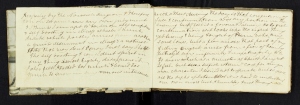1780-1845
Elizabeth Fry (née Gurney), Penal Reformer and Philanthropist, was born on 21 May 1780 at Magdalen Street, Norwich, daughter of the Quakers, John and Catherine Gurney. Among her siblings were the philanthropists Joseph John and Samuel Gurney, the banker and antiquary Daniel Gurney and Louisa Gurney Hoare. Their mother died young leaving the younger children to be brought up by the eldest daughter Kitty. Their upbringing was unconventional for the time.
When Elizabeth was eighteen years old she reaffirmed her religious beliefs after hearing the travelling American Quaker William Savery speak. She was also inspired by fellow female Quakers, her cousin Priscilla Hannah Gurney and Deborah Darby. The following year she adopted Quaker dress and speech.
On 19 August 1800, Elizabeth Gurney married Joseph Fry (1777–1861), from a family of devout and wealthy Quakers. The couple went on to have eleven children. They first lived at St Mildred’s Court in London and then Plashet House in East Ham. Elizabeth undertook work in the community distributing clothing, food, and medicine to the poor, and was an advocate of vaccination, and contributed to the near elimination of smallpox among the children of neighbouring villages. In 1811 she was acknowledged as a Quaker minister.
Early in 1813, Elizabeth visited the women’s side of Newgate prison in London to find several hundred female prisoners with their children, packed in a few crowded rooms. At this time there were a growing number of prison reformers but Elizabeth broke new ground in her desire to improve the circumstances of female prisoners.
In Norfolk she had lead Sunday school, in East Ham she was co-founder of a girls’ school. In Newgate prison her first innovation was a school for the prisoners’ children. She consulted the prisoners and prison authorities and introduced a system of classification of the prisoners, prison dress, constant supervision by a matron and monitors (chosen from among the prisoners), religious and elementary education, and paid employment. This resulted in a remarkable transformation in the conduct of the prisoners. Fry or one of her helpers visited Newgate daily; she herself read to prisoners from the Bible on Fridays. The work gained a more permanent basis in April 1817 with the creation of the Ladies’ Association for the Reformation of the Female Prisoners in Newgate, extended in 1821 into the British Ladies’ Society for Promoting the Reformation of Female Prisoners, with correspondents in Russia, Italy, Switzerland, and the Netherlands.
The British Ladies’ Society appears to have been the first nationwide women’s organization in Britain.
Elizabeth then made a number of journeys through England, Scotland, and Ireland, combining her work as a Quaker minister with prison reform. She visited prisons, suggested measures for improvement to the local authorities, and established ladies’ committees for visiting female prisoners. In 1827 she published her handbook Observations on the Visiting, Superintendence, and Government, of Female Prisoners, and in 1840 Hints on the Advantages and the Duties of Ladies’ Committees who Visit Prisons. Two related causes taken up by her were capital punishment and the treatment of female prisoners on board convict ships to New South Wales, Australia, which she managed to improve substantially.
In 1828 Fry’s husband’s bank went bankrupt, and Joseph Fry was disowned by the Quakers and the family had to move to a smaller house in West Ham. Elizabeth was then confronted with opposition to her prison work, which was labelled amateurish. However with the financial support of her brothers Elizabeth persevered expanding her journeys promoting prison reform, the abolition of slavery and religious toleration alongside preaching. She also established a Maternal Society in Brighton in 1813, libraries for the coastguard of England, several district visiting societies, a servant’s society, and a Society of Nursing Sisters (1840), the first attempt to reform nursing in Britain.
Elizabeth died at Ramsgate on 13 October 1845, and was buried on 20 October in the Quaker burial-ground at Barking.
Elizabeth Fry contributed to dramatic improvements in British prison conditions and to revisions in the criminal law. In Europe, the USA, Canada, and Australia her name became synonymous with the compassionate treatment of prisoners. She is commorated in Norfolk, the United Kingdom and across the world.
In May 2002 she became only the second woman (after Florence Nightingale) to appear on a Bank of England note (five pounds). She is shown reading to prisoners at Newgate Prison. The design also incorporates a key, representing the key to the prison which was awarded to Fry in recognition of her work.

Elizabeth Fry plaque, Gurney Court, 1957. Photographer George Swain
Publication prohibited without the permission of Norfolk County Council
Two plaques commemorate her birthplace in Norwich, at Gurney Court, off Magdalen Street and at Earlham Hall. In February 2007 a new plaque was placed in her honour on the Friends Meeting House in Upper Goat Lane, Norwich.
On the campus of The University of East Anglia, the School of Social Work and Psychology is housed in the Elizabeth Fry building.
There is a plaque at St. Mildred’s Court, in London, where she lived when she was first married.
There is a terracota bust of her in the gatehouse of HM Prison Wormwood Scrubs.
There is a stone statue of her in the Old Bailey.
A plaque has been placed at the site of Arklow House, her home and place of death in Ramsgate by the Ramsgate Society.
Her resting place at the former Society of Friends Burial Ground, off Whiting Avenue in Barking, Essex, was restored and on 8 October 2003, a new commemorative plinth made of marble was officially unveiled.
Elizabeth Fry is also depicted on two panels of the Quaker Tapestry, panels E5 and E6.
The Canadian Association of Elizabeth Fry Societies honours her memory by advocating for women who are in the criminal justice system. They also celebrate and promote a National Elizabeth Fry Week in Canada each May.
There is an Elizabeth Fry Ward in Scarborough Hospital in North Yorkshire..
In the Lady Chapel of Manchester’s Anglican Cathedral one of the portrait windows features Elizabeth Fry.
On the former British television series Rumpole of the Bailey, a replica of the Elizabeth Fry statue in the Old Bailey is featured prominently in scenes set in the lobby.
There is a road named after Elizabeth Fry at Guilford College, a Quaker Founded School in Greensboro, NC
There is a bust of Elizabeth Fry located in the Study Area of East Ham Library, Newham Borough of London.
Find out more: You can see original documents about Elizabeth Fry at the Norfolk Record Office here

‘Diploma’ appointing Elizabeth Fry honorary Member of ‘La Société établie dans les Pays-Bas pour l’amelioration morale des Prisonniers’, with a letter from John Mollet (“Foreign Secretary” of the Society) referring to her appointment and to her work with prisoners in England. He expresses a wish that she may encourage ladies in the Netherlands to similar work.
11 March 1838

Original Journals of Elizabeth Fry.
Beginning as a young woman, before her marriage and ending about the commencement of her last illness, 1816-1818, 1821-1822.



Created in 2014 by UEA Film, Media and Television students Michael Town, Michael Stamper and Bernardo Leyte.













